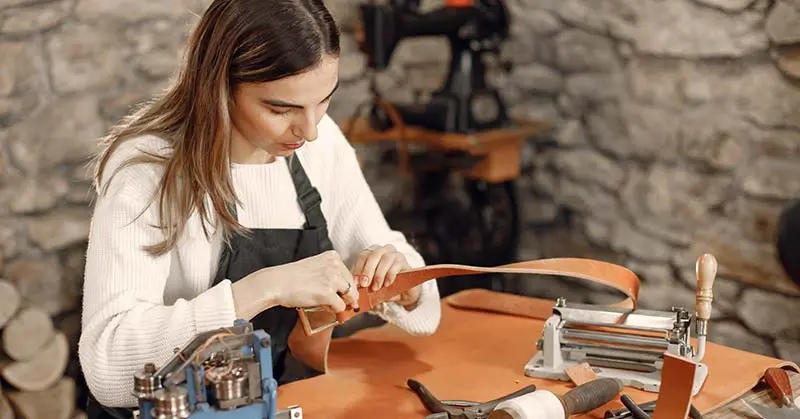The Ultimate Guide To Leather Garden Tool Belts
Leather Garden Tool Belts: Garden tool belts are essential equipment for any gardener, whether you’re a professional landscaper or a weekend hobbyist. They offer numerous advantages that can enhance your gardening experience in several ways. Here’s an overview of the importance of a garden tool belt:
Organization and efficiency: A garden tool belt has multiple pockets and compartments that can hold various tools, such as secateurs, trowels, gloves, seed packets, and more.
With a tool belt, your tools are within arm’s reach, saving you the time and effort you’d otherwise spend going back and forth to fetch tools from a toolbox.
Safety: Keeping sharp tools like pruners or trowels in a tool belt rather than lying around reduces the risk of accidental injury. It also protects your devices from getting lost or misplaced in the garden.
Comfort and mobility: A good garden tool belt is designed for comfort. It distributes the weight of the tools evenly around your waist, reducing strain on your body. This allows for better mobility and reduces fatigue, letting you work longer and more comfortably.
Durability: A garden tool belt is built to last with rugged materials that withstand rough handling and outdoor conditions. This durability means you can rely on it for many gardening seasons.
Professionalism: A tool belt also signals professionalism for professional landscapers and gardeners. It shows you’re serious about your work, helping to create a positive impression on clients.

Why leather is an ideal material for garden tool belts
Leather is a preferred material for garden tool belts for several reasons. First, its unique combination of durability, aesthetic appeal, and ease of maintenance makes it an excellent choice for such an essential piece of gardening equipment.
Durability: Leather is a notably durable material. It’s resistant to tear and wear and can withstand harsh outdoor conditions. With proper care, a leather tool belt can last for years, if not decades, providing excellent value for money.
Aesthetics: Leather carries a timeless appeal. Its natural look and feel make it aesthetically pleasing and only improves with age. A leather garden tool belt serves practical purposes and adds a touch of elegance and sophistication to your gardening attire.
Comfort: Leather is flexible and tends to mold to the shape of your body over time. This makes a leather tool belt more comfortable, even for extended periods. In addition, the more you use it, the more it conforms to your waist, providing a custom-fit feel.
Maintenance: Although leather needs some care, it’s relatively easy to maintain. Regular wiping to remove dirt and occasional conditioning to prevent drying and cracking will keep your leather tool belt in excellent condition.
Furthermore, leather is resistant to fungal attacks, dry abrasion, dust, and more.
Versatility: Leather is a versatile material that can be treated and stitched in various ways, allowing for different styles and designs. So, you can always find a leather tool belt that fits your style and needs.
Different types of garden tool belts
Garden tool belts come in various shapes, sizes, and designs to cater to gardeners’ diverse needs and preferences. Here are some of the different types of garden tool belts that you might come across:
Waist tool belt: This is the most common type. As the name suggests, it is worn around the waist and usually comes with multiple pockets and pouches of varying sizes to hold different garden tools.
Apron tool belt: This type is similar to a waist tool belt but extends upwards to cover part of the torso. Apron tool belts offer additional space for tools and protect your clothing.
Suspenders tool belt: This one comes with suspenders that go over your shoulders, helping to distribute the weight more evenly and reduce strain on your lower back. They’re a good option if you have a lot of heavy tools to carry.
Holster tool belt: This type usually has one or two large pouches to hold specific tools, such as pruners or trowels. They’re smaller and more lightweight than others but offer less storage space.
Combination tool belt: Some tool belts combine the features of different types, such as a waist tool belt with detachable suspenders or an apron with a holster pouch.
Customizable tool belt: These tool belts come with removable pouches that can be rearranged according to your needs. They offer a high level of versatility and adaptability.
Leather tool belt: These are tool belts made of leather. They’re known for their durability, comfort, and aesthetic appeal. They come in all the types mentioned above.
Each type of garden tool belt has its strengths and is suitable for different situations and preferences. When choosing a tool belt, consider the number and size of tools you usually use, the mobility you need, your comfort, and your style.
Top leather garden tool belt features to Look for
Choosing a leather garden tool belt can be a significant investment, so knowing what features to look for is essential. Here are some key considerations:
Number and sizes of pockets: The primary purpose of a garden tool belt is to hold your tools, so you’ll want to make sure it has enough pockets and compartments.
Consider the tools you use most often, and make sure the belt has suitable spaces for them. Pockets should be deep enough to secure your devices but not so profound that they’re hard to reach.
Adjustable size and comfort: Comfort is crucial for a tool belt you’ll wear for extended periods. Look for a belt with adjustable straps so you can customize the fit. Leather is an excellent material for comfort, as it tends to mold your body over time.
Attachment options for different tools: Some garden tool belts have specialized attachments for particular tools, like loops for hammers or clips for tape measures. If you use specific tools regularly, look for a belt to accommodate them.
Quality of stitching and hardware: A garden tool belt’s durability depends greatly on its construction quality. Look for firm, even stitching straps and high-quality hardware, like buckles and rivets. A well-made leather tool belt should last for many years with proper care.
Easy maintenance: While leather is generally easy to maintain, some finishes are easier to clean than others. Also, look for belts with removable or washable pouches for added convenience.
Weather resistance: Gardening involves exposure to various weather conditions. Therefore, a good leather garden tool belt should be weather-resistant. Leather is naturally water-resistant, but some belts may be treated for extra protection.
Aesthetic appeal: Last but not least, you might want a belt that looks good. Leather is a classic material that never goes out of style, and it comes in many finishes, from rough and rugged to smooth and polished.
Best practices for using a leather garden tool belt
A leather garden tool belt can significantly improve your gardening efficiency and enjoyment. Here are some best practices for using a leather garden tool belt:
Load it properly: Arrange your tools in a way that makes sense for your workflow. Keep the tools you use most often in the easiest-to-reach pockets. Be mindful not to overload your tool belt, making it heavy and uncomfortable.
Wear it comfortably: Adjust the belt to a comfortable position on your waist. It should be tight enough to stay in place but loose enough not to restrict your movement or circulation.
Distribute weight evenly: To prevent back pain or discomfort, try to distribute the weight of the tools evenly across the belt. This might mean using the pockets on both sides of the belt rather than loading all your tools on one side.
Safety precautions: Be aware of the tools you have in your belt to prevent accidents. For instance, ensure sharp tools like pruners are secured in their pockets and not sticking out where they could cut or scrape you.
Regular maintenance: Remove any dirt or plant material from your belt after each use. Occasionally, treat the leather with a suitable conditioner to keep it supple and prevent it from drying out or cracking.
Proper storage: When not in use, store your tool belt in a cool, dry place out of direct sunlight. This will help to preserve the leather and extend the life of your belt.
Respect the leather: Remember that leather is a natural material that certain things can damage. Avoid using harsh chemicals or abrasive brushes to clean your tool belt.
Final Thoughts
A leather garden tool belt is an ideal tool for every gardener. Its blend of durability, aesthetic appeal, and practicality provides the perfect companion for gardening tasks, promoting efficiency and safety.
From different types of tool belts to their various features and ways of use, this guide should have given you a comprehensive understanding of leather garden tool belts.
Remember, investing in a high-quality leather tool belt is not just buying a product; it’s investing in a better gardening experience. So, choose wisely and let your tool belt be your trusted assistant in your gardening journey.


